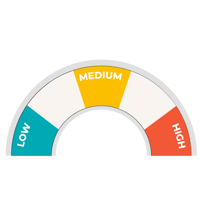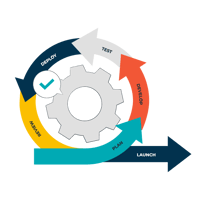“Move fast, break things” — there’s a problem with this mantra. It just doesn't work with every team and it doesn’t apply to every business sector.
What does “move fast, break things” really mean?
The concept of moving quickly is frequently linked to a fast-paced and highly innovative work setting. It motivates employees to adopt a sense of urgency and venture into uncharted territory to achieve swift advancements and continuous product refinement.
This approach places significant importance on speed and adaptability, urging individuals and teams to deliver outcomes promptly while accepting a possible risk of failure.
The catchphrase was famously coined by Mark Zuckerberg, and the technology industry took the ball and ran with it.
However, what often goes unmentioned is that the developers at Facebook had already discovered a method to swiftly progress with certainty even before they applied this ideology to their work culture.
They recognized that to effectively move quickly, they required appropriate systems and processes that would facilitate their desire for accelerated speed.
Unquestionably, work culture plays a crucial role in upholding the principles of the "move fast, break things" motto. A culture that appreciates transparent communication, collaboration, and psychological well-being empowers employees to openly exchange ideas, offer feedback, and gain insights from their missteps. It fosters a mindset of growth, where failures are viewed as valuable learning experiences rather than occasions for retribution or fault-finding.
Consequently, a robust and adaptable company culture serves as the bedrock for embracing swift progress and handling the possibility of encountering challenges along the way.
What you need to consider to effectively move fast
When attempting to move fast without considering the potential for failure, there are several consequences that can arise.
Failure to follow a well-engineered approach, which utilizes reliable tools for monitoring and observing operations, will inevitably result in unnecessary disruptions. As a result, additional time and resources will be required to address any incidents caused by these disruptions.
Furthermore, if these disruptions impact client-facing or mission-critical components, it can lead to a loss of customer trust and sales. This makes it essential to recognize that moving fast without adequate safeguards in place can have detrimental effects on both operational efficiency and the overall success of the organization.
How to break things and not fail
As with any endeavor, the context and setting play a significant role. When it comes to moving quickly, it is crucial to evaluate the situation in its entirety.
Firstly, a culture of psychological safety among all stakeholders and individuals involved is necessary. It is essential to consider the point at which accelerated velocity introduces unmitigated risks to the broader system.
Before deciding to pursue rapid progress, it is prudent to weigh the potential risks against the anticipated rewards. If things are unnecessarily moving too swiftly, valid concerns may arise regarding process integrity, additional strain on resources, the time required for corrective actions, and the unintended consequences that the change might have on other interconnected components within a holistic system.
Therefore, careful consideration of the risk-reward balance is vital to make informed decisions about the pace of progress.
Additionally, before you set out on moving fast, it’s important to consider how any updates or changes to a system could affect stakeholders and any individuals involved with a stake in the matter.
For example, have you sought consultation with the individual who was initially responsible for developing the system or process? Should they have been informed about any modifications that may directly affect their involvement?
“You have to work hard to get your thinking clean. But, it's worth it in the end because once you get there, you can move mountains.”
- Steve Jobs, Apple Co-founder
Here are 10 helpful suggestions for successfully navigating this approach without running the risk of failure. These tips can be applied to various industries, regardless of the particular circumstances involved:
 1. Plan and prepare:
1. Plan and prepare:
Before implementing any changes or initiatives, create a well-thought-out plan that outlines the desired outcomes, potential risks, and mitigation strategies. Adequate preparation helps minimize the chances of failure.
 2. Test and validate:
2. Test and validate:
Prioritize testing and validation to identify potential issues or weaknesses. Conduct thorough testing in controlled environments to ensure the reliability and effectiveness of your processes, products, or services.
 3. Foster a culture of continuous learning:
3. Foster a culture of continuous learning:
Encourage a culture of curiosity, learning, and adaptation within your organization. Embrace a growth mindset that views failures as valuable learning opportunities and promotes innovation and improvement.
 4. Emphasize communication and collaboration:
4. Emphasize communication and collaboration:
Foster open communication channels and promote collaboration among team members. Encourage sharing ideas, concerns, and insights to facilitate better decision-making and problem-solving.
 5. Implement risk management strategies:
5. Implement risk management strategies:
Identify and assess potential risks associated with your projects or initiatives. Develop and implement risk management strategies that proactively address these risks, such as contingency plans or mitigation measures.
 6. Gather and analyze data:
6. Gather and analyze data:
Utilize data-driven insights to make informed decisions and measure the impact of your actions. Implement data collection and analysis systems to monitor progress, identify trends, and detect potential issues early on.
 7. Seek feedback from stakeholders:
7. Seek feedback from stakeholders:
Engage with your stakeholders, including customers, employees, and partners, to gather feedback and insights. Actively listen to their perspectives and incorporate their feedback into your decision-making and improvement processes.
 8. Prioritize scalability and flexibility:
8. Prioritize scalability and flexibility:
Design systems, processes, and products with scalability and flexibility in mind. Anticipate future growth and changing market conditions to ensure that your solutions can adapt and evolve accordingly.
 9. Invest in talent development:
9. Invest in talent development:
Continuously invest in the development of your employees' skills and knowledge. Provide training opportunities, encourage professional growth, and empower your team to contribute their expertise to drive success.
 10. Regularly evaluate and iterate:
10. Regularly evaluate and iterate:
Continuously evaluate the effectiveness of your strategies, processes, and products. Embrace a mindset of continuous improvement and iterate on your approaches based on the insights gained through evaluation.
Conclusion
Attempting to move fast without the proper engineered approach — or as Steve Jobs once put it, without “getting your thinking clean” — can lead to a cascade of negative effects. What’s more, failure to prioritize robust observability and monitoring tools can result in incidents and breakages that demand additional time and resources to resolve. And, some breakages can even come with severe and long-lasting consequences.
In summary, the mantra "work fast, break things" can thrive in a work culture that embraces innovation, agility, and continuous learning. When supported by a company culture that values open communication, collaboration, and learning from failures, it can lead to breakthroughs, increased productivity, and a dynamic work environment. However, it's crucial to maintain a balanced approach that considers the impact on quality and customer satisfaction, ensuring that speed and innovation are not pursued at the expense of stability and overall success.
About the author
 Sandro Mezzacappa
Sandro Mezzacappa
Sandro is the VP of Product & Marketing for Applauz Recognition. He’s been with the company since the very beginning and has the distinction of being Applauz’s very first employee.

